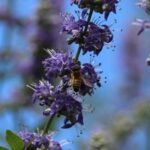The Eastern Redbud, known for its stunning lavender-pink blossoms that adorn its branches in early spring, is a popular choice among gardeners and landscapers alike. This deciduous tree is native to the eastern United States and can grow up to 30 feet tall with a spread of 25-35 feet. Its heart-shaped leaves turn a beautiful yellow in the fall, making it an attractive addition to any landscape.
As a plant care and growing guide expert, I am excited to share my knowledge on how to best care for this beautiful tree. From selecting the right location to pruning techniques and pest control, this guide will provide you with all the information you need to successfully grow and maintain an Eastern Redbud in your own backyard. Whether you are a seasoned gardener or just starting out, this guide will serve as a valuable resource for serving others by creating a beautiful outdoor space.
Overview Of The Eastern Redbud
One interesting fact about the Eastern Redbud is that it is the state tree of Oklahoma, a testament to its popularity and cultural significance. Growing up to 30 feet in height with a spread of up to 25 feet, this deciduous tree boasts beautiful pinkish-purple flowers that bloom in early spring before the leaves emerge. Its heart-shaped leaves turn yellow in fall, adding to its ornamental value.
Aside from its aesthetic appeal, the Eastern Redbud has several plant characteristics that make it an attractive addition to any garden or landscape. It is a low-maintenance tree that can tolerate various soil types, including clay soils and acidic soils. Additionally, it is drought-tolerant and can withstand periods of dryness without significant damage.
Historically, Native Americans used the inner bark of the Eastern Redbud as a medicinal herb for treating ailments such as fever and dysentery. Today, it is primarily grown for its ornamental value and environmental benefits. The Eastern Redbud plays a vital role in supporting wildlife, providing food and habitat for birds and other animals. Overall, growing an Eastern Redbud offers numerous benefits for both the environment and aesthetics of any outdoor space.
As we move on to discussing the benefits of growing eastern redbuds, it’s important to note that beyond their beauty and environmental contributions, they also offer practical advantages for homeowners and gardeners alike.
Benefits Of Growing Eastern Redbuds
Growing eastern redbuds can provide a range of benefits related to both the environment and landscaping ideas. The beautiful pink and purple flowers that bloom in early spring make them a popular ornamental tree for gardens and public spaces. When planted in groups, they create a stunning visual display that is sure to impress. Moreover, their small size makes them an excellent choice for smaller gardens or as an understory tree in larger landscapes.
In addition to being aesthetically pleasing, eastern redbuds offer numerous environmental benefits. They are highly beneficial for pollinators like bees and butterflies, who rely on the nectar-rich flowers for food. Furthermore, the trees produce nitrogen-fixing nodules on their roots that help enrich the soil with nutrients essential for plant growth. This means they can be used as companion plants to support other nearby plants.
Eastern redbuds are also renowned for their hardiness and adaptability to various growing conditions, including drought and poor soil quality. This means they require minimal maintenance compared to other trees while still providing all of their associated benefits. With so many advantages of growing eastern redbuds, it’s no wonder they’re such a popular choice among gardeners and landscapers alike.
With all these benefits considered, it’s important to choose the right location when planting your eastern redbud tree(s). The ideal spot will be one that receives ample sunlight but also has some shade during hot summer months. It should also have well-draining soil that isn’t too compacted or waterlogged. Careful consideration of these factors will ensure your tree(s) thrive and continue providing all of their associated benefits for years to come.
Choosing The Right Location
As we have seen, eastern redbuds offer a multitude of benefits that make them an excellent addition to any garden. However, before planting your own redbud tree, it is important to consider the location in which it will thrive best. One critical aspect to keep in mind when choosing a location is sun exposure. Eastern redbuds are known for their love of sun and require plenty of direct sunlight throughout the day to grow and flourish.
Another factor to consider when selecting a location for your eastern redbud tree is soil type. These trees are quite adaptable and can grow well in a variety of soil types, including clay, loam, and sand. However, they prefer soil that is slightly acidic with good drainage capabilities. If you’re unsure about the pH level of your soil or its drainage capacity, you can test it using an at-home kit or consult with a gardening expert.
In addition to these two key considerations, it’s also essential to keep other factors in mind such as spacing requirements and potential obstacles like neighboring structures or power lines. By taking all of these factors into account when choosing your location, you’ll be well on your way to cultivating a healthy and vibrant eastern redbud tree that will bring joy and beauty to your garden for years to come.
Moving forward into the next section about soil requirements, it’s important to note that while eastern redbuds can tolerate various soil types – not all soils are created equal. Understanding how different soil types affect the growth and development of this species will be crucial in ensuring its long-term success in your garden.
Soil Requirements
When it comes to growing eastern redbuds, the type of soil used plays a significant role in determining the plant’s success. Eastern redbuds thrive in well-draining soils that are rich in organic matter. There are three types of soil that work best for eastern redbud trees: sandy loam, loam, and clay loam. Sandy loam is ideal for areas with low rainfall because it drains quickly, while clay loam is excellent for areas with high rainfall because it retains water.
Soil preparation techniques are equally important when planting an eastern redbud tree. Before planting, the soil should be loosened to a depth of at least 12 inches to improve drainage and root growth. The addition of organic matter such as compost or well-aged manure can also help improve the soil’s texture and nutrient content. It is essential to avoid compacting the soil during planting or afterward since this can interfere with drainage and root growth.
In summary, selecting appropriate soil and preparing it correctly is crucial for successful eastern redbud tree growth. Sandy loam, loam, and clay loam are the most suitable types of soils for eastern redbuds, depending on their location’s rainfall levels. Proper preparation techniques like loosening the soil and incorporating organic matter will help create ideal growing conditions for your tree. Now that we understand how crucial proper soil preparation is for our eastern redbuds’ health let us move on to discussing their watering needs.
Watering Needs
Eastern Redbud plants require regular watering to ensure healthy growth and blooming; frequency should be determined by the climate and soil type of the area. Good quality water is also essential for the health of Eastern Redbud plants; tap water is usually suitable but rainwater or collected water should also be considered. Watering should be done with the aim of keeping the soil moist, and not soaking wet, to prevent overwatering. Additionally, mulching around the base of Eastern Redbud plants can help reduce the frequency of watering.
Watering Frequency
Picture this: on a sunny day, the eastern redbud’s lush green leaves and delicate pink blossoms sway gently in the breeze. To maintain this beauty, proper watering is crucial. Eastern redbuds require consistent moisture levels to thrive, but over-watering can be just as detrimental to their health as under-watering.
Establishing a watering schedule is the key to keeping your eastern redbud healthy. During the growing season, water your tree weekly or every 10 days if there hasn’t been any rain. However, adjust your watering frequency according to weather conditions and soil moisture levels. If the soil feels dry an inch below the surface, it’s time to water your tree.
When determining how much water your eastern redbud needs, consider factors such as temperature and humidity levels. In hot summer months or during droughts, you may need to increase watering frequency to ensure that your tree gets enough moisture. However, avoid over-watering by allowing the topsoil to dry between each watering session. Remember that proper watering practices are essential for maintaining healthy foliage and vibrant blooms throughout the growing season.
Water Quality
Maintaining healthy foliage and vibrant blooms of the eastern redbud tree requires proper watering practices. However, apart from the quantity and frequency of watering, water quality also plays a significant role in ensuring optimal growth. Various elements found in water can affect the pH level of soil, which can impact plant growth. Therefore, understanding the importance of water quality management is essential for effective watering practices.
The right pH level helps plants absorb nutrients efficiently and grow healthily. The pH level of the eastern redbud tree’s soil should be slightly acidic to neutral, between 6.0 and 7.5 on the pH scale. Water with high alkaline content can raise the pH levels too high, while acidic water can lower them too much. Testing your water source’s pH level is crucial to determine if it needs additional treatments or amendments to adjust its acidity or alkalinity.
When managing water quality for your eastern redbud tree’s watering needs, consider using rainwater or distilled water instead of tap water that may contain impurities or minerals that can affect soil acidity levels over time. Collecting rainwater in barrels is an excellent way to ensure a consistent supply of clean and safe water for your plants throughout the growing season. In conclusion, regular monitoring of water sources’ pH levels is crucial in maintaining optimal growing conditions for your eastern redbud tree.
Fertilization Tips
After ensuring that your eastern redbud is receiving enough water, the next step to ensuring optimal growth and health is fertilization. Fertilizers provide essential nutrients that your plant needs to thrive, such as nitrogen, phosphorus, and potassium. There are two main types of fertilizers: organic and chemical. Organic fertilizers are made from natural materials such as compost and animal manure, while chemical fertilizers are made from synthetic compounds.
Both types of fertilizers have their advantages and disadvantages. Organic fertilizers are generally considered safer for the environment and can improve soil quality over time. However, they may not provide nutrients as quickly or efficiently as chemical fertilizers. On the other hand, chemical fertilizers can provide an immediate nutrient boost to your plant, but they can also harm beneficial soil organisms if overused.
The best time to fertilize your eastern redbud is in early spring before new growth appears. This will give your plant a boost of nutrients when it needs it most. You can also apply a second round of fertilizer in late summer or early fall to encourage healthy root development before winter sets in. When applying fertilizer, be sure to follow the instructions on the package carefully and avoid over-fertilizing, which can damage your plant’s roots.
As you prepare to care for your eastern redbud, remember that proper maintenance is key to ensuring its long-term health and beauty. In the next section, we’ll cover pruning techniques that will help keep your tree looking its best year after year.
Pruning Techniques
Pruning is an essential aspect of eastern redbud plant care that helps to maintain its shape and promote healthy growth. Regular pruning ensures that the plant does not become overcrowded, which can lead to diseases and insect infestations. It also helps to remove dead or damaged branches, which can impede the development of new shoots.
Pruning frequency largely depends on the age and size of the eastern redbud tree. Young plants need more frequent pruning than mature ones as they grow more rapidly. The best time to prune is in late winter or early spring when the plant is still dormant. Shaping techniques such as thinning, heading, and pinching can be used to achieve various results. Thinning involves removing entire limbs from the trunk to open up space within the tree’s canopy while heading involves cutting back branches to stimulate new growth.
Pinching is a technique used for shaping small shrubs by removing just the tips of the growing branches. This promotes branching and increases foliage density, resulting in fuller shrubs. When pruning eastern redbuds, it’s essential to use sharp tools like loppers or hand pruners that make clean cuts without tearing bark or wood tissue. This helps prevent damage to the plant’s health and appearance.
| Pruning Technique | Purpose | How-to |
|---|---|---|
| Thinning | To open up space within canopy | Identify overgrown branches close to main trunk; Remove at point where it meets trunk; Avoid leaving stubs |
| Heading | To stimulate new growth | Cut back branch tips; Make cuts above a bud facing outward; Avoid removing too many buds |
| Pinching | To increase foliage density | Use fingers or pruners to remove just tip of growing branch; Done regularly throughout growing season |
Incorporating these pruning techniques into your eastern redbud plant care routine will keep your tree looking healthy and vibrant all year round. However, pruning should be done with caution as improper techniques can cause more harm than good. In the next section, we will discuss common pests and diseases that affect eastern redbuds and how to prevent them from causing damage to your plant.
Common Pests And Diseases
Aphids are small, soft-bodied insects that feed on the sap of plants such as the eastern redbud. Infestations of aphids can stunt the growth of a plant and cause leaves to yellow or curl. Control of aphid infestations can be achieved through physical removal or the use of insecticides.
Powdery mildew is a fungal disease that can affect the eastern redbud. Symptoms of this disease include a white, powdery growth on the leaves and stems, as well as the yellowing and curling of leaves. Control of this disease can be achieved through the application of fungicides and by providing adequate air circulation.
Root rot is a fungal disease that can occur when the eastern redbud is planted in a wet, poorly drained location. Symptoms of this disease include wilting, yellowing and eventual death of the plant. Control of this disease can be achieved by improving the drainage of the soil and avoiding over-watering.
Aphids
As you gaze upon the stunning beauty of your eastern redbud, the sight of aphids feasting on its leaves can be a frustrating experience. These tiny insects, also known as plant lice, can cause severe damage to your beloved plant by sucking out its sap and causing discoloration. The good news is that with proper care and attention, these pests can be prevented and eliminated.
One effective way to control aphids is by introducing their natural predators into your garden. Ladybugs are particularly effective in controlling aphid populations as they feed on them without harming your plants. Additionally, lacewings and hoverflies are also great options for warding off aphids naturally.
An organic solution for getting rid of aphids is by using a mixture of water and dish soap. Simply combine one teaspoon of liquid dish soap with one quart of water and spray it onto affected areas. Another option is to use a neem oil solution which not only kills aphids but also prevents them from laying eggs. By taking these steps to prevent and eliminate aphids, you will ensure the health and beauty of your eastern redbud for years to come.
Powdery Mildew
As a plant care and growing guide expert, it is important to be aware of common pests and diseases that can affect the health of your plants. One such issue is powdery mildew, a fungal disease that can cause significant damage to certain types of plants, including the eastern redbud.
Powdery mildew appears as a white or grayish powdery substance on the leaves, stems, and flowers of affected plants. It can spread quickly in humid or moist conditions, making prevention key. To prevent the spread of powdery mildew, it is important to provide adequate air circulation around your plants by spacing them appropriately and pruning any dense growth.
Treating powdery mildew can be done through a variety of methods. One option is to use a fungicide specifically designed for this disease. Alternatively, you can try using a mixture of baking soda and water or neem oil sprayed onto affected areas. It is important to act quickly when treating powdery mildew to prevent further spread and damage to your plant.
Root Rot
As a plant care and growing guide expert, another common pest and disease that can cause damage to plants is root rot. This condition occurs when the roots of a plant become waterlogged or damaged by a fungal infection, preventing them from absorbing nutrients properly. Signs of root rot include yellowing leaves, stunted growth, and a foul odor emanating from the soil.
Preventing root rot is crucial for maintaining healthy plants. One way to prevent this condition is to avoid overwatering your plants, as this can lead to waterlogged soil that encourages fungal growth. Additionally, it is important to ensure proper drainage in your planting containers or garden beds by using well-draining soil and adding drainage holes if necessary.
If you suspect your plant has root rot, there are steps you can take to address the issue. First, remove the affected plant from its container or bed and remove any dead or decaying roots. Next, repot the plant in fresh soil with improved drainage to prevent further damage. In severe cases of root rot, it may be necessary to discard the plant entirely to prevent the spread of the disease to other nearby plants.
Prevention And Treatment Of Pest Infestations
Pest infestations can be a serious threat to the health and growth of eastern redbuds. To ensure a healthy plant, it is essential to use an integrated pest management (IPM) approach. IPM involves preventing pest problems before they occur, rather than relying solely on chemical treatments.
One of the most effective methods of natural pest control is ensuring that your eastern redbud receives proper care. A healthy plant is less susceptible to pests and diseases, so make sure to provide adequate water, sunlight, and nutrients. Additionally, regularly inspect your plant for signs of damage or infestation. Early detection can help prevent the spread of pests and minimize damage.
If you do notice signs of an infestation, there are several natural pest control methods that can be used before resorting to chemical treatments. These include introducing beneficial insects such as ladybugs or lacewings, using insecticidal soap or neem oil sprays, and physically removing pests by hand. It’s important to note that these methods may take longer than chemical treatments but are safer for both the environment and your plant in the long run.
Incorporating IPM techniques along with proper care will help prevent pest problems from occurring in your eastern redbud. By using natural pest control methods when necessary, you can protect your plant while also minimizing harm to beneficial insects and other wildlife in your garden.
As you continue caring for your eastern redbud, it’s important to understand propagation methods for future growth opportunities.
Propagation Methods
When it comes to propagating the eastern redbud, there are various methods that can be used. One of these is air layering, which involves creating a small wound on the stem of the plant and covering it with soil or sphagnum moss. This encourages roots to grow from the wound, which can then be cut off and planted as a new tree. This method is particularly useful for those who want to create a clone of an existing eastern redbud tree.
Another propagation method that can be used for eastern redbuds is division propagation. This involves digging up an established tree and dividing its root ball into smaller sections, each of which can then be planted as a new tree. This method is particularly useful when an established tree has become too large for its current location and needs to be split up.
Both air layering and division propagation require a certain level of skill and knowledge in order to be successful. It is important to research these methods thoroughly before attempting them, and to ensure that all necessary tools and equipment are available. With the right care and attention, however, it is possible to propagate beautiful eastern redbud trees using these techniques.
Looking forward, once your propagated eastern redbud trees have reached maturity, you may need to transplant them into larger containers or into your garden or yard. Transplanting can be a delicate process that requires careful attention to detail in order to avoid damaging the tree’s roots or causing stress. In the next section, we will explore some useful tips for transplanting your young eastern redbud trees successfully.
Transplanting Tips
Transplanting Tips:
When transplanting an eastern redbud, timing is everything. The best time to transplant the tree is in the fall or early spring when the tree is dormant. Transplanting during this period will reduce the shock to the plant and increase its chances of survival. It’s important to choose a location that provides adequate sunlight and well-draining soil.
To ensure a successful transplant, you’ll need a few tools. A shovel or spade will be necessary for digging up the tree and its root ball. It’s also recommended to have a wheelbarrow on hand to transport the tree to its new location. When digging up the tree, it’s important to dig deep enough to include as much of the root system as possible.
Mistakes to avoid when transplanting an eastern redbud include damaging the root system, planting in compacted soil, or exposing the roots to direct sunlight for extended periods. Aftercare tips include watering regularly but not overwatering, mulching around the base of the tree, and monitoring for any signs of stress or disease. Following these tips will ensure your transplanted eastern redbud thrives in its new environment.
As we move into different seasons, it’s important to adjust our care routines accordingly. In our next section, we’ll provide a seasonal care guide for your eastern redbud so that you can keep your tree healthy and vibrant all year round.
Seasonal Care Guide
While the Eastern Redbud is a relatively low maintenance plant, it still requires seasonal care to thrive. One popular theory is that fall foliage should be left on the ground to protect plants from winter damage. However, this theory is not entirely accurate. While leaving some leaves on the ground can provide insulation and nutrients for the soil, too much can actually harm the plant by preventing air circulation and harboring pests and diseases.
To ensure proper seasonal care for your Eastern Redbud, it’s important to have a plan in place for winter protection. This may include wrapping the trunk with burlap or using frost blankets to cover the branches during cold snaps. It’s also essential to prune any dead or damaged branches before winter sets in, as these can become heavy with snow and ice and cause further damage to the plant.
In summary, fall foliage should be managed carefully to avoid potential harm to your Eastern Redbud. Additionally, taking steps for winter protection will help ensure healthy growth and vibrant blooms come springtime. Continue reading for troubleshooting common problems that may arise when caring for your Eastern Redbud plant.
Troubleshooting Common Problems
As a responsible plant owner, it is important to be aware of the common problems that may affect the growth and health of your eastern redbud. Identifying symptoms early on can help prevent further damage and ensure that your plant stays healthy. One common problem is fungal infections, which can cause leaf spots or wilted foliage. To prevent this, avoid overwatering and provide good air circulation around the tree.
Another issue that may arise is pest infestation. Eastern redbuds are susceptible to various pests, including aphids, caterpillars, and borers. If you notice any signs of pest damage such as holes in leaves or sticky residue on foliage, it is important to take immediate action. Pest control measures include using insecticidal soap or neem oil to kill off pests and prevent them from returning.
By being proactive in identifying symptoms and taking necessary pest control measures, you can ensure that your eastern redbud thrives year-round. In addition to ensuring proper care for your plant’s health, there are also ways to enhance its appearance for maximum curb appeal. The next section will cover tips for landscaping with eastern redbuds and incorporating them into your outdoor decor.
Enhancing Curb Appeal With Eastern Redbuds
The Eastern Redbud is a magnificent plant that can bring life to any landscape. Landscaping with Eastern Redbuds can enhance the curb appeal of your home and give it a vibrant look. This tree can be used as an accent, foundation, or specimen planting in the front yard or backyard to create an eye-catching view.
Curb appeal ideas with Eastern Redbuds are endless. Here are some ways you can incorporate this beautiful tree into your landscape:
- Planting one or two trees on either side of your driveway can make a grand entrance.
- Using them as a backdrop for other plants or flowers in the garden can create depth and interest.
- Placing them near windows will provide shade and privacy while adding beauty to your home’s exterior.
- Creating a focal point in your front yard by using Eastern Redbuds as a centerpiece planting is another great idea.
- Finally, combining different colors and textures of plants with Eastern Redbuds will add more depth and contrast to your landscape design.
Landscaping with Eastern Redbuds requires proper care and maintenance. It is essential to follow the correct guidelines for pruning, watering, fertilizing, and pest control. With proper care, this tree will thrive in your landscape for many years to come.
In conclusion, landscaping with Eastern Redbuds is an excellent way to enhance your home’s curb appeal. By following proper care guidelines and incorporating these creative ideas into your landscape design, you can enjoy the beauty of this stunning tree while increasing the value of your property. Stay tuned for final tips on how to care for and maintain this tree in the next section.
Conclusion And Final Tips
After following the steps outlined in this guide, you should have a healthy and thriving eastern redbud tree. However, proper maintenance is crucial to ensure that your tree continues to flourish. Here are some tips for maintaining your eastern redbud:
- Pruning: Regular pruning will help keep your tree in shape and promote healthy growth. It’s best to prune during the dormant season, which is typically in late winter or early spring before new growth appears.
- Watering: While eastern redbuds are fairly drought-tolerant, they still require consistent watering during their first few years of growth. After that, they can generally survive on natural rainfall alone.
- Fertilizing: Eastern redbuds don’t require much fertilizer, but it can be beneficial to apply a slow-release fertilizer in the spring to encourage healthy growth.
Not only does caring for an eastern redbud benefit the individual tree itself, but it also has benefits for the environment as a whole. These trees provide food and habitat for wildlife such as birds and butterflies, and their beautiful pink flowers add aesthetic value to any landscape. Additionally, planting more trees helps combat climate change by absorbing carbon dioxide from the atmosphere.
Overall, growing an eastern redbud is a rewarding experience that not only adds beauty to your surroundings but also contributes positively to the environment. By following these tips for maintenance and recognizing the benefits of planting trees, you can ensure that your tree thrives while also making a positive impact on the world around you.
Conclusion
The Eastern Redbud is a stunning tree that can add beauty and elegance to any garden or landscape. With its striking pink and purple blooms in the spring, it’s no wonder why so many gardeners are drawn to this unique plant. In this plant care and growing guide, we’ve provided all the information you need to successfully grow an Eastern Redbud.
From choosing the right location to troubleshooting common problems, we’ve covered everything you need to know. Remember that proper soil preparation, watering, and seasonal care are key factors in ensuring the health and longevity of your tree. With a little bit of effort and attention, you can have a beautiful Eastern Redbud that will provide years of enjoyment.
In conclusion, the Eastern Redbud is a wonderful addition to any garden or landscape. Its vibrant colors and unique shape are sure to impress guests and passersby alike. By following our expert advice on plant care and growing techniques, you can enjoy a healthy and thriving tree for years to come. So don’t hesitate – add an Eastern Redbud to your garden today!
Image Credits
- “Eastern Redbud flowers, Cercis canadensis, Newberry, SC” by Martin LaBar (featured)





























